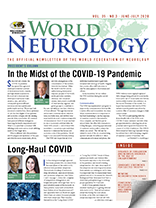by Peter J. Koehler
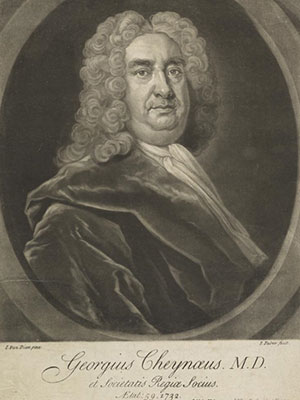
Figure 1. George Cheyne
The relation between civilization and disease has been known for centuries. Researchers found evidence that in the pre-history period, small hunter-gatherer populations tended to be less troubled by disease. With growing population density following the settlement of farmers around 12,000 years ago (in the Neolithic period), and later the start of commercial traveling and increasing mobility, pathogens could spread easier. Yersinia pestis (bubonic plague in the Late Middle Ages), Treponema pallidum (syphilis, starting around 1500), and Variola (smallpox, in particular during the 17th and 18th century) are well-known examples. Sometimes whole nations were associated with a disease, the best example being the “Spanish disease” and “morbus Gallicus,” referring to syphilis. In the Renaissance period, there was already some knowledge about the spread, and quarantine protocols were promoted in some places upon the arrival of ships (40 days, hence the word quarantine, from the French “quarant”). In periods of plague, markets and city gates were closed.
Not Only Contagious Diseases
Another type of disease of civilization was recognized in the 18th century and associated with the “secularized revamping of the Christian legend of the Fall, wherein Original Sin and the expulsion from Paradise had inaugurated the regime of hard labor, disease, suffering, and death in the temporal world.”1 Several physicians in this period, including the Scottish physician George Cheyne (1672-1743; Figure 1; not to be confused with John Cheyne [1777-1837]), who practiced in London and Bath, and the Swiss physician Samuel August Tissot (1728-1797; Figure 2), and also philosopher Jean-Jacques Rousseau (1712-1778) pointed to the relatively healthy hunter-gatherer and peasant people of the early days, who were engaged in physical labor, exercise in the open air, and taking healthy foods. Town life in the 18th century with its commerce, wealth, indoor work, and bad habits, including taking too much food and alcohol and too little exercise, could easily lead to health problems, which often resulted in the use of opiates, tobacco, more alcohol, and remedies.1 According to Tissot, “gens des lettres” were particularly prone, and he even dedicated a book to the subject in 1768, De la santé des gens des lettres [On the health of men of learning], which was published in several editions at least up to 1826 and considered an important publication in the history of occupational disease. In his preface, the author indeed referred to the pioneer Bernardino Ramazzini (1633-1714, author of De Morbis Artificum Diatriba / Diseases of Workers).
Tissot’s Santé des gens des lettres
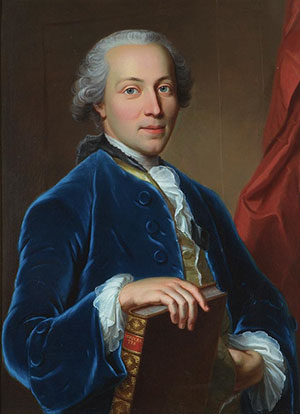
Figure 2. Samuel-Auguste Tissot (Collection de l’université de Lausanne
In his De la santé des gens des lettres (Figure 3), Tissot referred to numerous cases from medical literature described by well-known physicians. The association was already known ages ago, as for instance Galen of Pergamon (129-c210) described the history of the peripatetic philosopher Premigenes, who lived a life of reading and writing, thereby not perspiring well, for which he had to take a bath every day, to avoid accumulation of the sharps humours.2 More recent physicians included Jean Fernel (1497-1558), Johann Jakob Wepfer (1620-1695), and Giovanni B. Morgagni (1682-1771), who associated mental efforts and exhaustion, which led to severe or even mortal disease. Wepfer, for instance, mentioned the case of a young man (22 years old), who studied day and night, became delirious, hurt several people, and killed his guard.2 Tissot also referred to Gerard van Swieten (1700-1772) and his Commentaria in Hermanni Boerhaave aphorismos de cognoscendis et curandis morbis (5 vols. 1742-72), in which he wrote about “Les Gens de Lettres qui mènent une vie sédentaire, & qui pâlissent sur leurs livres, sont souvent exposés à une apoplexie.” [“Men of learning, who live a sedentary life, and turn pale above their books, are often exposed to apoplexia.”)2 Hypochondria was also a well-known ailment, Tissot believed. “Parmi les maux que la vie sédentaire de Hommes des Lettres produit presqu’inévitablement en dérangeant la circulation dans les viscères du bas-ventre & y produisant un principe d’obstructions, on doit comptant l’hypocondrie.” (“Among the ailments that are almost inevitably caused by the sedentary life of men of learning by deranging the circulation of the bowels of the abdomen and there producing a source of obstructions, one has to reckon hypochondria.”)2 Tissot not only wrote on men, but also mentioned women, for instance a 50-year-old woman, who had read books at night in her youth and then started suffering from insomnia and fluxions. With respect to the causes, he mentioned the air around these persons that was rarely freshened, in contrast to the pure and fresh air from the fields, continuation of the work during a part of the night, and lack of exercise leading to “cardialgia,” which had already been noted by Aretaeus of Cappadocia (first century CE) and Aetius of Amida (mid-fifth and mid-sixth century).2
Rousseau
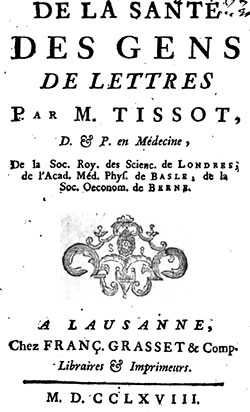
Figure 3. Title page of Tissot’s book [On the health of men of learning
Seated in the Nervous System
Several physicians, including the mentioned Cheyne and Tissot, believed that these modern diseases from abundance and sedentary life had their seat in the nervous system, writing about a nervous tone. These physicians did not always apply contemporary humoral pathophysiological theories that still reigned, at the time (although Cheyne was still writing in terms of “interruption or interception of the vibrations of the nerves by the viscidity of juices”). The excessive food and alcohol, in combination with a lack of exercise, would result in obstruction of nervous fibers that led to all kinds of complaints that were not observed in people who led a healthier life in the countryside. The term “nervousness” became fashionable for physicians as well as patients. Physicians came to believe that many of the current diseases had a nervous origin. Remarkably, nervous disorders had a positive connotation as it was believed to be observed in particular in intelligent and rich people, the beau monde. Interestingly, gout, at the time, was another disease that had the same connotation and was associated with wealth, food, and alcohol.
In this way a psychosomatic paradigm seemed to play an important role in the age of Enlightenment. Not only organic causes, but also ideas, imagination, and emotions were taken into consideration. Much more could be said about the further development of this concept during the 19th century — degeneration ideas, social Darwinism, nervous exhaustion, and neurasthenia with the work of George Beard (1839-1883) and Silas Weir Mitchell (1829-1914) — and 20th century — eugenics starting with Francis Galton (1822-1911) and ending in the Nazi cruelties — but let us keep to the 18th century here.
Cheyne’s English Malady
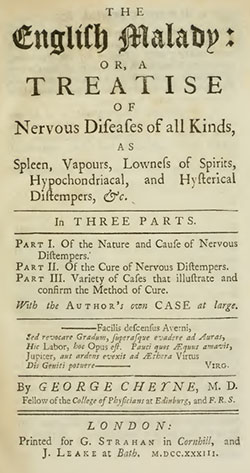
Figure 4. Title page of Cheyne’s book.
Not only the mentioned part of society was susceptible for these diseases, but even whole nations were associated with it. Cheyne’s book was named The English Malady (Cheyne, 1733; Figure 4). In the preface he noted that “all our Neighbors on the Continent, by whom nervous Distempers, Spleen, Vapors, and Lowness of Spirits, are in Derision called [it] the English Malady. And I wish there were not so good Grounds for this Reflection.” He continued to mention the reasons for this, including “the Moisture of our Air, the Variableness of our Weather … the Rankness and Fertility of our Soil, the Richness and Heaviness of our Food, the Wealth and Abundance of the Inhabitants (from their universal Trade), the Inactivity and sedentary Occupations … and the Humor of living in great, populous and consequently unhealthy Towns.”4 Furthermore, it is of interest to write out the whole title of the book, as it occurs on the title page, The English Malady: or, a Treatise of Nervous Diseases of all Kinds, as Spleen, Vapours, Lowness of Spirits, Hypochondriacal, and Hysterical Distempers, as well as the titles of the three divisions of the book, notably Part I. Of the Nature and Cause of Nervous Distempers; Part II. Of the Cure of Nervous Distempers; Part III. Variety of Cases that illustrate and confirm the Method of Cure; to which Cheyne added “With the Author’s own case at large.”
In chapter six, “of the Frequency of Nervous Disorders, in later Years, beyond what they have been observed in former Times,” we find information on the three main causes, including 1) luxury; 2) an inactive, sedentary, or studious life; and 3) living in great and populous cities. Most, if not all, of the cases described came from the higher classes, indeed finishing with an extensive description of his own condition, with intermittent fever and “vertiginous Paroxysm, so extremely frightful and terrible, as to approach near to a Fit of an Apoplexy … I found after this, some small Returns of my Vertigo (in Bed especially) on lying on a particular Side…” (This episode seems to have been benign paroxysmal positional vertigo.) Later he suffered from headache, depression, and anxiety, as he “went about like a Malefactor condemned, or one who expected every Moment to be crushed by a ponderous Instrument of Death”. 4

Figure 5a. From Classification of diseases from William Cullen’s Synopsis Nosologiae Methodicae (American edit. of 1783).
Nosological Systems and Neurosis
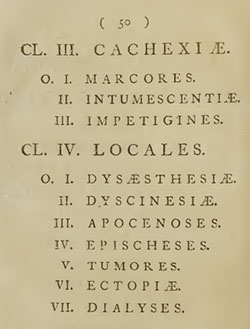
Figure 5b. From Classification of diseases from William Cullen’s Synopsis Nosologiae Methodicae (American edit. of 1783).
The importance of the nervous system as the origin of diseases was also recognized by Robert Whytt (1714-1766), professor of the theory of medicine at the University of Edinburgh, although he had a different approach. He noticed that nervous diseases may mimic somatic conditions and can be strongly influenced by emotions, sometimes being triggered by intense imagination. His successor Wiliam Cullen (1710-1790), who drew up an important nosological system, believed that the category of nervous diseases — he coined the term neurosis — was the most important among four categories (although historian of science Dyde pointed to the differences of view with this respect between Whytt and Cullen). In this age of nosology, in which diseases were classified in a similar way as Carl Linnaeus (1707-1778) did with the plant world (he also made a nosological system of diseases), Cullen classified diseases into 1) pyrexiae (fevers); 2) neuroses ; 3) cachexiae; and 4) locales (Figure 5). His classification influenced the French physician Philip Pinel (1745 – 1826), who recognized neuroses of the senses, cerebral function, locomotion and voice, nutrition, and sexual function. It may be regarded a mixture of diagnoses from modern neurology and psychiatry, although other diseases were still classified within this category. The class of neurosis mainly included diseases that Pinel considered “functional,” and this contained more diseases than we would call psychiatric nowadays (and the term cannot be equated with its later use by Freud). This functional orientation of neurosis remained during almost the whole 19th century, though the category of neuroses became smaller in the course of the century as more diseases were found to have a neuropathological substrate. In the 1880s, for example, William Gowers (1845-1915) mentioned the following functional disorders: chorea, paralysis agitans, tremor, tetanus, tetany, occupation neurosis, etc.
Conclusion
In conclusion, the 18th century disease of civilization, associated with abundance and sedentary life, and its treatment looks familiar to us today. The association these physicians made with the nervous system is of interest against the background of the psychosomatic perspective. The concept of nervous disorder or neurosis at the time, however, was much broader than today, a kind of repository, and cannot be compared with its use in the early 20th century (psychoneurosis).
